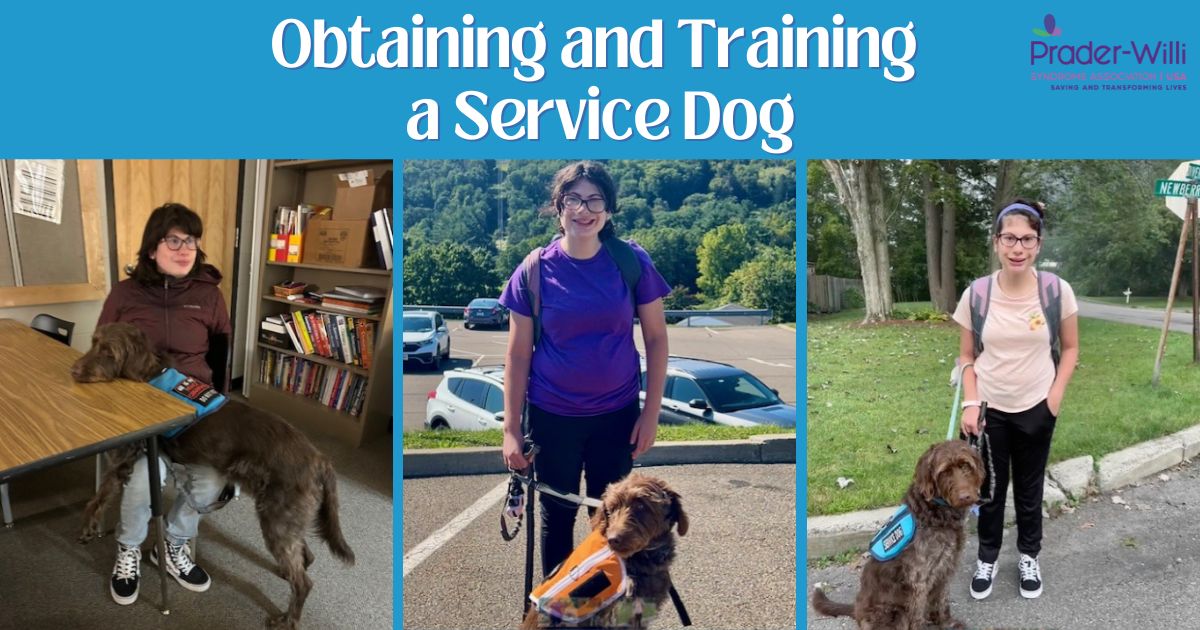Contributed by Rachel Johnson
People have called us “lucky” to have a service dog. I chuckle when I hear this because the reality is, we didn’t get a service dog for the fun of it. Although having Stanley in our lives is a true joy, we worked for him because we needed the help. Life with Prader-Willi Syndrome is physically and emotionally challenging for the individual living with PWS and their families.
When Ellie, now 17 years old, was in 6th grade we were battling emotional and physical meltdowns that were taxing on her and us. We had tried behavioral interventions, many different medications and supplements. Something would work for a little while, but eventually she would revert back to her baseline behaviors. We were completely at our wits end when we decided to look into getting a service dog.
Once I took a deep dive into obtaining a service dog, I realized that I was going to have to be creative and persistent. We live in Upstate NY and the only organization that trains service dogs was dedicated to helping veterans. Other organizations that train dogs for our needs were far away and very expensive with the biggest obstacle being the amount of time that training would take. We were in a crisis situation and would have had to wait years between starting the process until actually receiving the dog. We didn’t have time to wait. The good news was that according to the ADA Federal Law, service dogs can be self-trained. In fact, there is no such thing as an official service dog certification as this could be cost prohibitive to people in need.
So I decided, in the spirit of no stones unturned, to go down the rabbit hole of finding and training our very own service dog. I started by reaching out to local dog trainers about how to find a dog to train. I learned that it was important to have a dog with the correct temperament for the training and the tasks required of them. This led me to a breeder who was known for breeding dogs with service/support temperaments and was knowledgeable in how to select the appropriate puppy for our needs. She had a litter on the way, and we had a few months to get ourselves ready for our new addition.
While we anxiously awaited Stanley’s arrival, I reached out to local dog trainers so I would have a team assembled to help me learn how to train him. A bunch of phone calls led me to the nicest man ever who wanted to help us but who was unsure about committing to this process. He was a seasoned dog trainer but not a service dog trainer specifically. He was worried about the training being unsuccessful and disappointing us. I told him that we needed to try this, assured him of our commitment, and convinced him him that the worst that could happen was our family ended up with a great dog that we will love forever, regardless of outcome. With that, he agreed to help in any way he could.
Stanley was born in January of 2019 and came home in May. Our dog trainer came to our house once a week to teach me how to train him. Service dogs need to be trained to pass a public access test and to perform specific tasks for the person they are helping. We trained Stanley to perform deep pressure therapy and to remind Ellie not to pull her hair out. Deep pressure therapy (DPT) helps to calm and ground someone when they are feeling anxious and stressed. Stanley is trained to lay on Ellie when she is either sitting or lying down. He can also lean against her when she is standing. It is important for service dogs to be trained to work in all environments. Since I am a high school teacher, I was able to start bringing Stanley to work with me beginning in September 2019. He came to school with me every day so he would be used to the commotion, sights, and sounds of a high school building.
After a couple years of training, and a covid shut down, Stanley was able to take the public access test with a 3rd party dog trainer. He passed with flying colors and was ready to go to school with Ellie. He started attending with her in 2021 when she started her freshman year and has continued going with her throughout high school. Ellie is now a senior and they are ready to graduate together. The teachers report that Stanley has helped her stay calmer and has de-escalate many meltdowns. We have seen the same at home. Stanley took meltdowns that would last for hours to minutes. He is an amazing source of support and devotion.
Stanley is still a dog, and only one tool in the tool belt. There are times when Ellie does not want his help. There are times when she is so far gone that he can’t help. There is a lot of planning and logistics involved with having him go to school with her. Sometimes it is like having another child. Having a service dog requires dedication to the process and a willingness to overcome some obstacles along the way. If you are willing to put in the effort required to train and maintain a service dog, the payoff is immeasurable. We absolutely cannot imagine our lives without Stanley. He has been a huge support to Ellie, in fact our whole family, in this PWS journey. He loves unconditionally, he calms in chaos, he lightens the mood, and he is the goodest boy!
Share this!





 Jennifer Bolander has been serving as a Special Education Specialist for PWSA (USA) since October of 2015. She is a graduate of John Carroll University and lives in Ohio with her husband Brad and daughters Kate (17), and Sophia (13) who was born with PWS.
Jennifer Bolander has been serving as a Special Education Specialist for PWSA (USA) since October of 2015. She is a graduate of John Carroll University and lives in Ohio with her husband Brad and daughters Kate (17), and Sophia (13) who was born with PWS. Perry A. Zirkel has written more than 1,500 publications on various aspects of school law, with an emphasis on legal issues in special education. He writes a regular column for NAESP’s Principal magazine and NASP’s Communiqué newsletter, and he did so previously for Phi Delta Kappan and Teaching Exceptional Children.
Perry A. Zirkel has written more than 1,500 publications on various aspects of school law, with an emphasis on legal issues in special education. He writes a regular column for NAESP’s Principal magazine and NASP’s Communiqué newsletter, and he did so previously for Phi Delta Kappan and Teaching Exceptional Children. Evan has worked with the Prader-Willi Syndrome Association (USA) since 2007 primarily as a Crisis Intervention and Family Support Counselor. Evans works with parents and schools to foster strong collaborative relationships and appropriate educational environments for students with PWS.
Evan has worked with the Prader-Willi Syndrome Association (USA) since 2007 primarily as a Crisis Intervention and Family Support Counselor. Evans works with parents and schools to foster strong collaborative relationships and appropriate educational environments for students with PWS. Dr. Amy McTighe is the PWS Program Manager and Inpatient Teacher at the Center for Prader-Willi Syndrome at the Children’s Institute of Pittsburgh. She graduated from Duquesne University receiving her Bachelor’s and Master’s degree in Education with a focus on elementary education, special education, and language arts.
Dr. Amy McTighe is the PWS Program Manager and Inpatient Teacher at the Center for Prader-Willi Syndrome at the Children’s Institute of Pittsburgh. She graduated from Duquesne University receiving her Bachelor’s and Master’s degree in Education with a focus on elementary education, special education, and language arts. Staci Zimmerman works for Prader-Willi Syndrome Association of Colorado as an Individualized Education Program (IEP) consultant. Staci collaborates with the PWS multi-disciplinary clinic at the Children’s Hospital in Denver supporting families and school districts around the United States with their child’s Individual Educational Plan.
Staci Zimmerman works for Prader-Willi Syndrome Association of Colorado as an Individualized Education Program (IEP) consultant. Staci collaborates with the PWS multi-disciplinary clinic at the Children’s Hospital in Denver supporting families and school districts around the United States with their child’s Individual Educational Plan. Founded in 2001, SDLC is a non-profit legal services organization dedicated to protecting and advancing the legal rights of people with disabilities throughout the South. It partners with the Southern Poverty Law Center, Protection and Advocacy (P&A) programs, Legal Services Corporations (LSC) and disability organizations on major, systemic disability rights issues involving the Individuals with Disabilities Education Act (IDEA), Americans with Disabilities Act (ADA), and the federal Medicaid Act. Recently in November 2014, Jim retired.
Founded in 2001, SDLC is a non-profit legal services organization dedicated to protecting and advancing the legal rights of people with disabilities throughout the South. It partners with the Southern Poverty Law Center, Protection and Advocacy (P&A) programs, Legal Services Corporations (LSC) and disability organizations on major, systemic disability rights issues involving the Individuals with Disabilities Education Act (IDEA), Americans with Disabilities Act (ADA), and the federal Medicaid Act. Recently in November 2014, Jim retired.